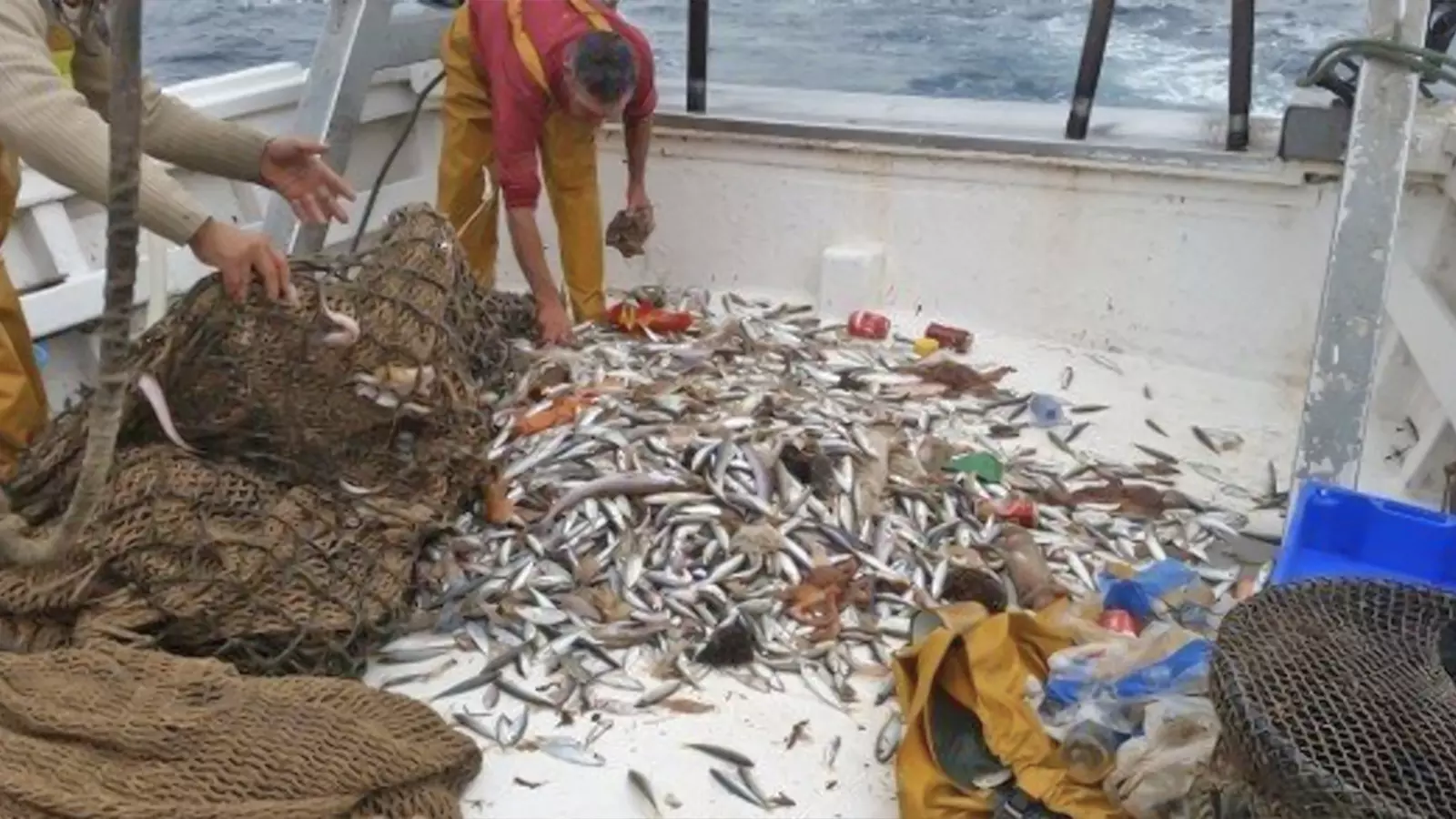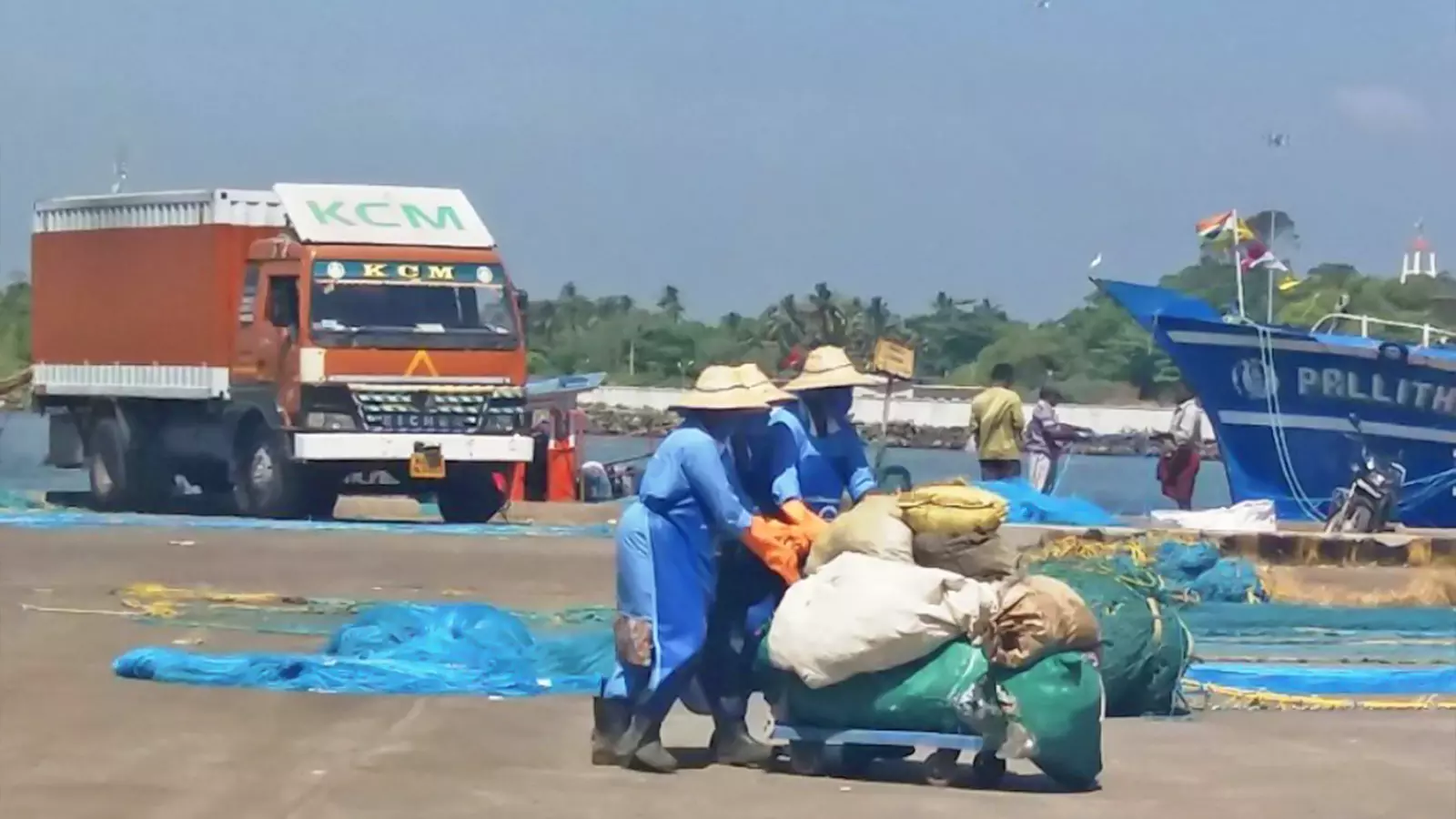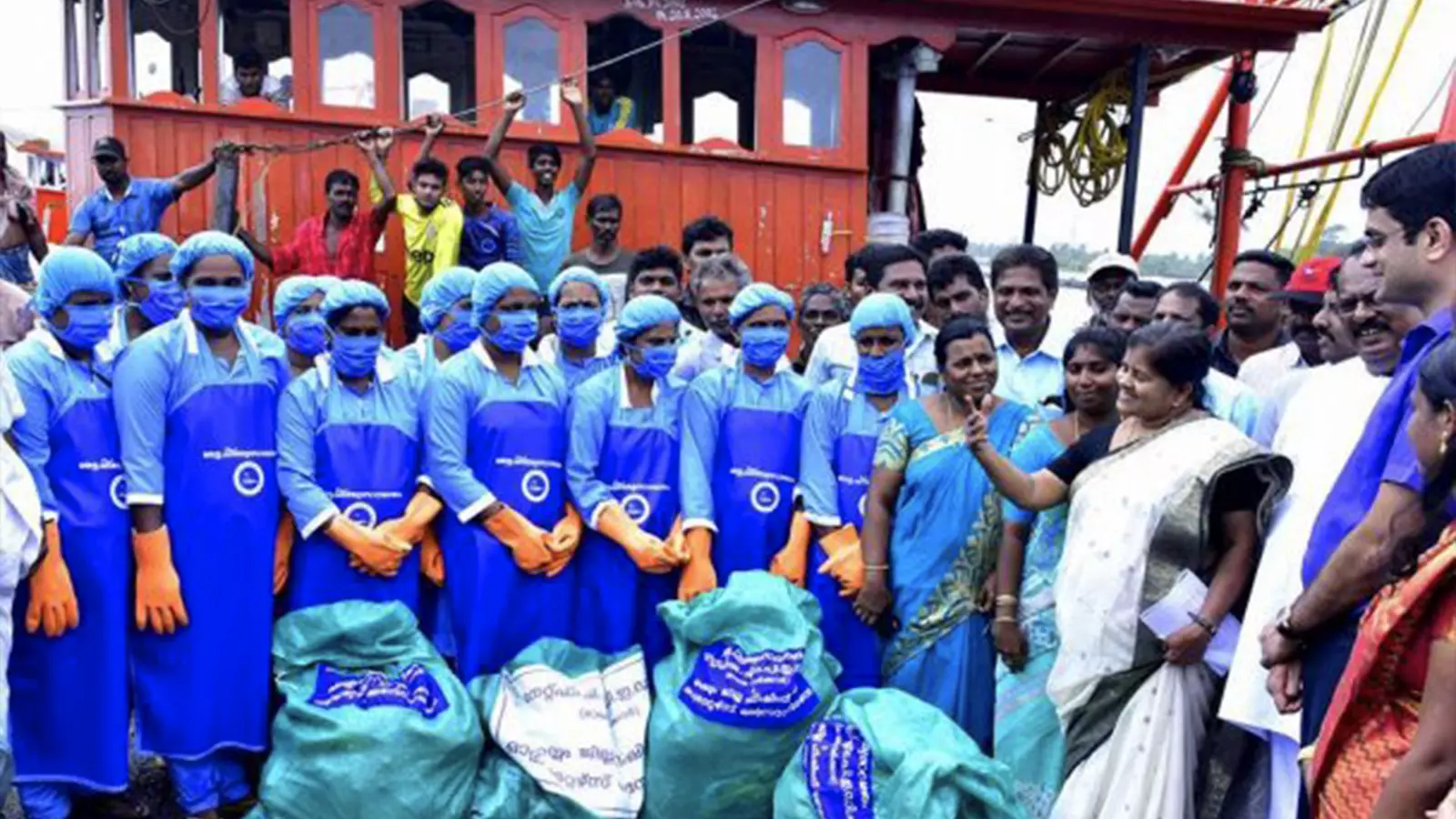
- Home
- India
- World
- Premium
- THE FEDERAL SPECIAL
- Analysis
- States
- Perspective
- Videos
- Sports
- Education
- Entertainment
- Elections
- Features
- Health
- Business
- Series
- In memoriam: Sheikh Mujibur Rahman
- Bishnoi's Men
- NEET TANGLE
- Economy Series
- Earth Day
- Kashmir’s Frozen Turbulence
- India@75
- The legend of Ramjanmabhoomi
- Liberalisation@30
- How to tame a dragon
- Celebrating biodiversity
- Farm Matters
- 50 days of solitude
- Bringing Migrants Home
- Budget 2020
- Jharkhand Votes
- The Federal Investigates
- The Federal Impact
- Vanishing Sand
- Gandhi @ 150
- Andhra Today
- Field report
- Operation Gulmarg
- Pandemic @1 Mn in India
- The Federal Year-End
- The Zero Year
- Science
- Brand studio
- Newsletter
- Elections 2024
- Events
Fishing for plastic: Why Kerala’s fishermen could lose livelihoods to plastic mounds
Fifty-year-old Abdulla Bava is no stranger to the reality of sea pollution. A fisherman hailing from Ponnani in the Malappuram district of Kerala, with over 35 years in the trade, Abdulla has, however, found himself increasingly worried of late. His worry is shared by his fellow fishermen.The recent spike in plastic waste in the deep sea is a nagging worry, which Abdulla says is...
Fifty-year-old Abdulla Bava is no stranger to the reality of sea pollution. A fisherman hailing from Ponnani in the Malappuram district of Kerala, with over 35 years in the trade, Abdulla has, however, found himself increasingly worried of late. His worry is shared by his fellow fishermen.
The recent spike in plastic waste in the deep sea is a nagging worry, which Abdulla says is ‘beyond words’. It’s not just about the community being environmentally conscious, but the issue has started hitting their livelihoods.
“I’ve been out there fishing in the Arabian Sea for a good 35 years now. Pollution has always been there, but the insane increase in plastic over the past 15 or 20 years is really getting to us. I mean, we're finding all sorts of plastic, from kitchen packaging to busted fishing nets. Some folks even use plastic on purpose to catch fish, and others just throw it into waterbodies, and it ends up in the sea,” Abdulla tells The Federal.
“Our nets are like magnets for this stuff, and it directly impacts our livelihood. We do our best to bring the plastic back to the shore, but there's no real system in place for getting rid of it properly. It’s frustrating, and you wouldn’t believe it, but even some fishermen just toss it back into the sea when it doesn’t mess up their nets. It’s a big problem with no solution in sight so far,” he adds.

Fishermen collect fish on a boat. If current trends persist, projections suggest that by 2050, the weight of plastics in the ocean will surpass that of fish in the ocean.
In 2017, a project titled Suchitwa Sagaram was initiated by NETFISH, Network for Fish Quality Management and Sustainable Fishing, a society formed under the aegis of Marine Products Export Development Authority (MPEDA) supported by the Kerala government, in Kollam district, with Neendakara harbour as its centre. Ever since the project kicked off, fishermen heading out to sea have been hauling tonnes of plastic waste back to the harbour.
The collected waste is sorted, shredded, and repurposed for road construction. Apart from NETFISH, Suchitwa Mission, Clean Kerala company, Harbour Engineering Department, Society for assistance to fisherwomen, department of fisheries, Kerala and Boat operators’ association of Kollam district were part of the pilot project.
“The project was started during the period of the first Pinarayi Vijayan government with Minister J Mercy Kutty Amma in the lead. But once the project was launched, not everything went as planned. There were 20-30 women who started working in collection and segregation of the waste. But because of lack of funds, many of them had to stop working,” says Michael, a fisherman who was very enthusiastic about the project.
“The plastic collected from the sea was brought back to the harbour by the fishermen, and we enlisted a team of fisherwomen to oversee the shredding unit at the harbour. When we initiated the project, there was no budgetary allocation. It was primarily a voluntary initiative. We collaborated with all stakeholders, including the Union government, fisherfolk, boat owners, and the general public to make the project a reality,” J Mercykutty Amma tells The Federal.
“Subsequently, we received significant appreciation, including recognition from the UN Economic Forum, and some financial assistance from a few NGOs. Toward the end of the first term of the Pinarayi Vijayan government, the state government allocated around Rs 2 crore for the project. However, it was deemed insufficient to meet the project’s needs,” added the former minister.

Suchitwa Keralam workers collecting plastic waste brought by fishermen from the seas at Neendakara Harbour.
A fisheries department official emphasised the tangible impact of the plastic pollution menace on fisher folk. “The plastic pollution menace is very real, and it is affecting the fishing community big time. Even though we do not know the exact magnitude of the problem yet, as not many studies have taken place, this is going to affect livelihoods for sure,” he says.
The official underscores the urgency of addressing the issue and the potential repercussions on the livelihoods of those involved in fishing.
“The issue is concentrated near the coast; the accumulation of plastic occurs primarily because it flows from the land. The deep sea is comparatively better. As a result, small-time fishermen are bearing the brunt of this problem,” says Sangeetha NR, state coordinator of NETFISH-MPEDA.
“The project was slated to expand to 24 fishing harbours across Kerala, named, Suchitwa Saagaram – Sundara Theeram (Clean Ocean, Beautiful Shores) by the state government. It has not materialised beyond some coastal cleaning initiatives yet,” says Sangeetha.
“It began without a clear idea of how to handle the materials retrieved from the ocean, particularly pollutants like plastic. There should have been a well-defined plan and guidelines for this. Currently, there’s no system in place for transporting these materials from the harbour. They’re currently being dumped in a storage facility, but there’s no subsequent processing or recycling in progress yet,” observes Dr Sureshkumar, professor of Aquatic Environment Management in Kerala university of fisheries and ocean studies.
According to a pre-COVID study, conducted by School of Industrial Fisheries, Cochin University of Science and Technology and Central Institute of Fisheries Technology, Kochi, “Plastic items were the most dominant type of waste constituting 73.8% by number and 59.9% by weight. In the total debris recorded, 5540 pieces (36%) weighing 198.4 kg (39.8%) were fishing related trash.”
According to globally available data, more than 9 million tonnes of plastic finds its way into the sea annually. If current trends persist, projections suggest that by 2050, the weight of plastics in the ocean will surpass that of fish in the ocean. The prolonged lifespan of plastics and inadequate management of end-of-life plastic have contributed to the emergence of marine plastic debris as a substantial issue in recent years.
“There exists an extensive garbage patch in the Pacific Ocean, equivalent in size to Iceland. When viewed from space, it stands out as the second-largest human-made structure on Earth. Additionally, another patch of similar nature is present in the Atlantic Ocean," points out Dr Suresh Kumar. But according to him, the most concerning issue in marine pollution is micro plastics.
The existence of microplastics, defined as minuscule plastic fragments measuring less than 5 mm, has become a huge global concern nowadays with all aquatic settings ranging from sea to local ponds and lakes getting seriously affected. As they get introduced into a waterbody, microplastics may either remain buoyant in the water column or descend to the sediment at the bottom, depending upon the density of the particles.
“In fact, microplastics are one of the biggest worries. They’ve been even found inside the bodies of pretty much every organism, including the fish we chow down on. The crazy part is, the waste we toss away ends up coming back as part of our food. It’s like this never-ending cycle that’s seriously affecting our health. All the stuff we throw out somehow ends up in the sea. So, people who depend on the sea are taking a hit,” says Dr Suresh Kumar.
“Even seemingly harmless things like those party poppers we use for celebrations add to this microplastic mess. When we wash polyester clothes, that adds to the problem too. Fish get confused, thinking these tiny particles are algae, and then they end up in their stomachs. When we eat these fishes or animals that have eaten such fishes, the microplastics finally end up in our stomachs and even our muscles,” he warns.

Former Minister and CPI(M) leader Mercy Kutty Amma with Suchitwa Sagaram workers.
The increasing reliance of our society on widespread plastic use, often without awareness, is irreparably harming the marine environment. Within the ocean, plastic materials afloat undergo degradation into smaller particles.
Marine plastic pollution leaves a lasting and never-ending impact on the entire ecosystem, not to mention humans who consume fish or other marine products, let alone humans who consume fish or other marine products.
“Plastic bags look a lot like jellyfish, and when turtles eat them, it’s pushing them towards extinction. There hasn’t been much research on this yet. We’re mostly blaming everything on climate change. The population of predators is getting messed up. As turtles disappear, jellyfish thrive causing a severe imbalance in our ecosystem,” Dr Suresh says.
“Tortoises and even big fishes dying from consuming plastic covers aren't a rare sight anymore,” shares PM Mohammed Koya, a fish trader from Thrissur district.
“We had a massive dead whale wash-up on one of our beaches not too long ago, and there were plastic debris inside its stomach. The fishermen who go for deep-sea fishing often complain to us about this problem. The government should take this issue more seriously, otherwise, it could get completely out of hand. There were talks about expanding the Kollam project statewide, but nothing has materialised after Covid. Maybe the government doesn’t have adequate funds,” adds Koya.
Abandoned fishing nets, especially the large ones known as gill nets that extend for kilometres, which have the potential to significantly disrupt fish and other creatures is another problem. Discarded fishing nets and other parts of equipment, often known as ‘ghost gear’, amass any abandoned or lost gear left in the marine environment. This gear persists in fishing, trapping, entangling — often called ghost fishing phenomenon by marine researchers — and potentially causing harm or death to marine life. It also poses a threat to navigation, smothers habitat, and stands as one of the primary forms of debris adversely affecting the marine environment.
Many academic studies have indicated that the fishing industry might have been playing a substantial role in contributing to marine plastic debris in India. However, there is a noticeable lack of systematically analysed information available on this subject.
In Kerala, the impact of marine plastic pollution, particularly the issue of microplastics, is not limited to the sea and coastal areas. It has significantly affected the backwaters as well.
According to a 2023 study published in Marine Pollution Bulletin, “Vembanad Lake water is greatly affected by microplastic pollution compared to other Indian lakes as it receives discharges from six rivers; a number of sewage canals and run-offs. Fibres constitute more than half of the total MPs in both subsurface and bottom waters.”
The study also points at the dominance of polyamide and polypropylene with most of the microplastics being fibres indicating that they originate probably from fishing activities and laundry wastewater’.
In the latter part of the previous century, plastics emerged as a major human-made pollutant, contaminating planet Earth’s water, soil, and air.
Despite awareness about the danger posed by plastic to human existence, according to the 2022 report of Plastics Europe, plastic production has surged from 50 million tons to 390.7 million tons in a span of 45 years until 2012.

